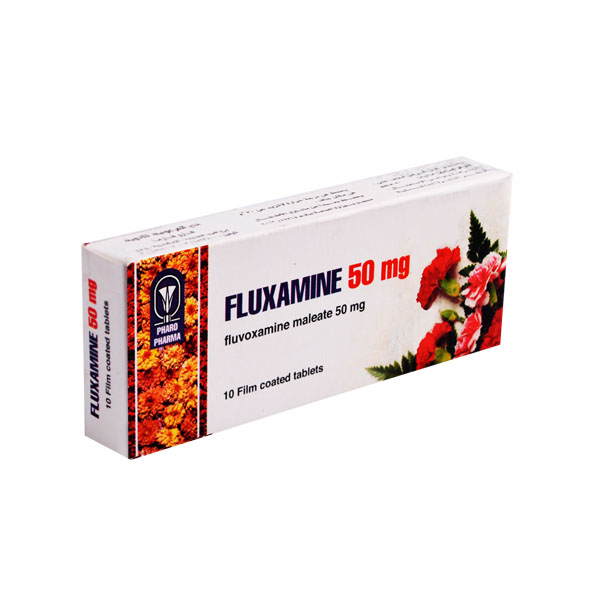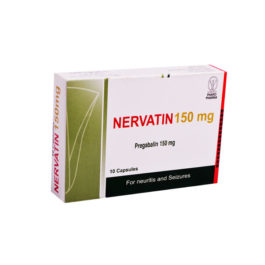Description
THERAPEUTIC INDICATIONS
– Major depressive episode.
– Obsessive Compulsive Disorder (OCD).
DOSAGE AND ADMINISTRATION
Depression
Adults
The recommended dose is 100 mg daily. Patients should start on 50 or 100 mg, given as a single dose in the evening. Dosage should be reviewed and adjusted if necessary within 3 to 4 weeks of initiation of therapy and thereafter as judged.
Doses up to 150 mg can be given as a single dose, preferably in the evening. It is advisable that a total daily dose of more than 150 mg is given in 2 or 3 divided doses. Dosage adjustments should be made carefully on an individual patient basis, to maintain the patients at the lowest effective dose.
Patients with depression should be treated for a sufficient period of at least 6 months to ensure that they are free from symptoms.
Children/adolescents
Fluxamine should not be used in children and adolescents under the age of 18 years for the treatment of major depressive episode.
Obsessive Compulsive Disorder
Adults
The recommended dose is between 100-300 mg daily. Patients should start at 50 mg per day.
Doses up to 150 mg can be given as a single dose, preferably in the evening. It is advisable that a total daily dose of more than 150 mg is given in 2 or 3 divided doses.
Children/adolescents
In children over 8 years and adolescents there is limited data on a dose of up to 100 mg b.i.d for 10 weeks. The starting dose is 25 mg per day. Increase every 4-7 days in 25 mg increments as tolerated until an effective dose is achieved. The maximum dose in children should not exceed 200 mg/day. (For further details see 5.1 and 5.2). It is advisable that a total daily dose of more than 50 mg should be given in two divided doses. If the two divided doses are not equal, the larger dose should be given at bedtime.
Withdrawal symptoms seen on discontinuation of fluvoxamine
Abrupt discontinuation should be avoided. When stopping treatment with fluvoxamine the dose should be gradually reduced over a period of at least one or two weeks in order to reduce the risk of withdrawal reactions.
Hepatic or renal insufficiency
Patients suffering from hepatic or renal insufficiency should start on a low dose and be carefully monitored.
Method of administration
Fluvoxamine tablets should be swallowed with water and without chewing.
CONTRAINDICATINONS
Fluxamine tablets are contraindicated in combination with monoamine oxidase inhibitors (MAOIs). Treatment with fluvoxamine can be initiated:
– two weeks after discontinuation of an irreversible MAOI, or
– the following day after discontinuation of a reversible MAOI (e.g. moclobemide).
At least one week should elapse between discontinuation of fluvoxamine and initiation of therapy with any MAOI.
Hypersensitivity to the active substance or to any of the excipients.
PRECAUTIONS AND WARNINGS
Suicide/suicidal thoughts or clinical worsening
Antidepressant drugs increase risk compared to placebo of suicidal thinking and behavior in children adolecents and young adults in short term studies of major depressive disorders (MMD) and (Suicidality) other psychiatric disorders.
Depression is associated with an increased risk of suicidal thoughts, self harm and suicide (suicide-related events). This risk persists until significant remission occurs. As improvement may not occur during the first few weeks or more of treatment, patients should be closely monitored until such improvement occurs. It is general clinical experience that the risk of suicide may increase in the early stages of recovery.
Other psychiatric conditions for which Fluxamine is prescribed can also be associated with an increased risk of suicide-related events. In addition, these conditions may be co-morbid with major depressive disorder. The same precautions observed when treating patients with major depressive disorder should therefore be observed when treating patients with other psychiatric disorders.
Patients with a history of suicide-related events, or those exhibiting a significant degree of suicidal ideation prior to commencement of treatment are known to be at greater risk of suicidal thoughts or suicide attempts, and should receive careful monitoring during treatment.
A meta-analysis of placebo-controlled clinical trials of antidepressant drugs in adult patients with psychiatric disorders showed an increased risk of suicidal behaviour with antidepressants compared to placebo in patients less than 25 years old.
Close supervision of patients and in particular those at high risk should accompany drug therapy especially in early treatment and following dose changes.
Patients (and caregivers of patients) should be alerted about the need to monitor for any clinical worsening, suicidal behaviour or thoughts and unusual changes in behaviour and to seek medical advice immediately if these symptoms present.
Akathisia/ Psychomotor restlessness
The use of fluvoxamine has been associated with the development of akathisia, characterised by a subjectively unpleasant or distressing restlessness and need to move, often accompanied by an inability to sit or stand still. This is most likely to occur within the first few weeks of treatment. In patients who develop these symptoms, increasing the dose may be detrimental.
Withdrawal symptoms seen on discontinuation of fluvoxamine treatment
Withdrawal symptoms when treatment is discontinued are common, particularly if discontinuation is abrupt
The risk of withdrawal symptoms may be dependent on several factors including the duration and dose of therapy and the rate of dose reduction.
Dizziness, sleep disturbances, nausea, headache and asthenia are the most commonly reported reactions.
Generally these symptoms are self-limiting and usually resolve within 2 weeks, though in some individuals they may be prolonged. It is therefore advised that fluvoxamine should be gradually tapered when discontinuing treatment over a period of several weeks or months, according to the patient’s needs.
Patients suffering from hepatic or renal insufficiency should start on a low dose and be carefully monitored.
Glycaemic control may be disturbed, especially in the early stages of treatment. The dosage of anti-diabetic drugs may need to be adjusted.
Although in animal studies fluvoxamine has no pro-convulsive properties, caution is recommended when the drug is administered to patients with a history of convulsive disorders. Fluvoxamine should be avoided in patients with unstable epilepsy and patients with controlled epilepsy should be carefully monitored. Treatment with fluvoxamine should be discontinued if seizures occur or if seizure frequency increases.
A life-threatening condition called serotonin syndrome can happen when medicines called selective serotonin reuptake inhibitors (SSRIs) and medicines used to treat migraine headaches known as hydroxytryptamine receptor agonists (triptans), are used together.
Serotonin syndrome is characterized by the development of at least three of the following clinical features after a recent change in a treatment regimen involving: agitation, ataxia, diaphoresis, diarrhoea, fever, hyperreflexia, myoclonus, shivering, changes in mental statusmental status.
As with other SSRIs, hyponatremia has been rarely reported, and appears to be reversible when fluvoxamine is discontinued. Some cases were possibly due to the syndrome of inappropriate antidiuretic hormone secretion. The majority of reports were associated with older patients.
here have been reports of the following haemorrhagic disorders: gastrointestinal bleeding, gynaecological haemorrhage, and other cutaneous or mucous bleeding with SSRIs. Caution is advised in patients taking SSRIs particularly in elderly patients and in patients who concomitantly use drugs known to affect platelet function (e.g. atypical antipsychotics and phenothiazines, most TCAs, acetylsalicylic acid, NSAIDs) or drugs that increase risk of bleeding, as well as in patients with a history of bleeding disorders.
Fluvoxamine should be used with caution in patients with a history of mania/hypomania. Fluvoxamine should be discontinued in any patient entering a manic phase.
When combined with fluvoxamine plasma concentrations of terfenadine, astemizole or cisapride may be increased resulting in an increased risk for QT-prolongation/Torsade de Pointes. Therefore, fluvoxamine should not be co-administered with these drugs.
Due to lack of clinical experience, special attention is advised in the situation of post-acute myocardial infarction.
There is limited clinical experience of concomitant administration of fluvoxamine and ECT therefore caution is advisable.
Data in elderly subjects give no indication of clinically significant differences in normal daily dosages compared to younger subjects. However, upward dose titration should be done slower in the elderly, and dosing should always be done with caution.
Use in children and adolescents under 18 years of age
Fluvoxamine should not be used in the treatment of children and adolescents under the age of 18 years, except for patients with Obsessive Compulsive Disorder. Suicide-related behaviours, and hostility were more frequently observed in clinical trials among children and adolescents treated with antidepressants compared to those treated with placebo.
INTERACTION WITH OTHER MEDICINAL PRODUCTS AND OTHER FORMS OF INTERACTION
Fluvoxamine should not be used in combination with MAOIs.
Fluvoxamine is a potent inhibitor of CYP1A2, and to a lesser extent of CYP2C and CYP3A4. Drugs which are largely metabolised via these isoenzymes are eliminated slower and may have higher plasma concentrations when co-administered with fluvoxamine. This is particularly relevant for drugs with a narrow therapeutic index. Patients should be carefully monitored and, if necessary, dose adjustment of these drugs is recommended.
Fluvoxamine has marginal inhibitory effects on CYP2D6 and seems not to affect non-oxidative metabolism or renal excretion.
CYP1A2
An increase in previously stable plasma levels of those tricyclic antidepressants (e.g., clomipramine, imipramine, amitriptyline) and neuroleptics (e.g., clozapine, olanzapine) which are largely metabolised through cytochrome P450 1A2 when given together with fluvoxamine, has been reported. A decrease in the dose of these products should be considered if treatment with fluvoxamine is initiated.
Patients co-administered fluvoxamine and CYP1A2 metabolised drugs with a narrow therapeutic index (such as tacrine, theophylline, methadone, mexiletine) should be carefully monitored and, if necessary, dose adjustment of these drugs is recommended.
When given with fluvoxamine, warfarin plasma concentrations were significantly increased and prothrombin times prolonged.
Isolated cases of cardiac toxicity have been reported when fluvoxamine was combined with thioridazine.
As plasma concentrations of propranolol are increased in combination with fluvoxamine, the propranolol dose may need to be lowered.
Caffeine plasma levels are likely to be increased during co-administration with fluvoxamine. Thus, patients who consume high quantities of caffeine-containing beverages should lower their intake when fluvoxamine is administered and adverse caffeine effects (like tremor, palpitations, nausea, restlessness, insomnia) are observed.
As plasma concentrations of ropinirole may be increased in combination with Fluvoxamine thus increasing the risk of overdose, surveillance and reduction in the posology of ropinirole during fluvoxamine treatment and after its withdrawal may be required.
CYP2C
Patients co-administered fluvoxamine and CYP2C metabolised drugs with a narrow therapeutic index (such as phenytoin) should be carefully monitored and, if necessary, dose adjustment of these drugs is recommended.
CYP3A4
Terfenadine, astemizole, cisapride.
Patients co-administered fluvoxamine and CYP3A4 metabolised drugs with a narrow therapeutic index (such as carbamazepine, ciclosporin) should be carefully monitored and, if necessary, dose adjustment of these drugs is recommended.
The plasma levels of oxidatively metabolised benzodiazepines (e.g. triazolam, midazolam, alprazolam, and diazepam) are likely to be increased when co-administered with fluvoxamine. The dosage of these benzodiazepines should be reduced during co-administration with fluvoxamine.
Glucuronidation
Fluvoxamine does not influence plasma concentrations of digoxin.
Renal excretion
Fluvoxamine does not influence plasma concentrations of atenolol.
pharmacodynamic interactions
The serotonergic effects of fluvoxamine may be enhanced when used in combination with other serotonergic agents (including tryptans, SSRIs and St. John’s Wort preparations).
Fluvoxamine has been used in combination with lithium in the treatment of severely ill, drug-resistant patients. However, lithium (and possibly also tryptophan) enhances the serotonergic effects of fluvoxamine. The combination should be used with caution in patients with severe, drug-resistant depression.
In patients on oral anticoagulants and fluvoxamine, the risk for haemorrhage may increase and these patients should therefore be closely monitored.
As with other psychotropic drugs patients should be advised to avoid alcohol use while taking fluvoxamine.
PREGNANCY AND LACTATION
Caution should be exercised when prescribing to pregnant women.
Isolated cases of withdrawal symptoms in the newborn child have been described after the use of fluvoxamine at the end of pregnancy.
Infant born to mother who took selective serotonin reuptake inhibitors (SSRI) after 20th week of pregnancy were 6 times more likely to have perisistent pulmonary hypertension (PPHN) than infant born to mothers who did not take antidepressant during pregnancy.
Fluvoxamine is excreted via human milk in small quantities. Therefore, the drug should not be used by women who breast feed.
EFFECTS ON ABILITY TO DRIVE AND USE MACHINE
Fluvoxamine up to 150 mg has no or negligible influence on the ability to drive and use machines. However, somnolence has been reported during treatment with fluvoxamine. Therefore, caution is recommended until the individual response to the drug has been determined.
UNDESIRABLE EFFECTS
Nausea, sometimes accompanied by vomiting is the most frequently observed symptom associated with fluvoxamine treatment. This side effect usually diminishes within the first two weeks of treatment. Other adverse events, observed in clinical studies at frequencies listed below, are often associated with the illness and are not necessarily related to treatment.
Common (Frequency 1-10%):
Body: Asthenia, headache, malaise
Cardiovascular: Palpitations/tachycardia
Digestive system: Abdominal pain, anorexia, constipation, diarrhoea, dry mouth, dyspepsia
Nervous system: Agitation, anxiety, dizziness, insomnia, nervousness, somnolence, tremor
Skin: Sweating
Uncommon (Frequency <1%):
Cardiovascular: (Postural) hypotension
Musculoskeletal: Arthralgia, myalgia
Nervous System: Ataxia, confusion, extrapyramidal symptoms, hallucinations
Urogenital: Abnormal (delayed) ejaculation
Skin: Cutaneous hypersensitivity reactions (incl. rash, pruritus, angioedema)
Rare (Frequency <0.1%):
Digestive system: Liver function abnormality
Nervous system: Convulsions, mania
Urogenital: Galactorrhoea
Skin: Photosensitivity
Psychomotor restlessness/akathesia (see Warnings and Precautions)
It is possible that withdrawal reactions may occur on stopping therapy with fluvoxamine although the available preclinical and clinical evidence does not suggest that this treatment causes dependence. The following symptoms have been reported in association with withdrawal of the product: dizziness, paresthesia, headache, nausea and anxiety. The majority of the withdrawal reactions are mild and self-limiting.
When stopping, a gradual dose reduction may be considered.
OVERDOSE
Symptoms
Symptoms include gastro-intestinal complaints (nausea, vomiting and diarrhoea), somnolence and dizziness. Cardiac events (tachycardia, bradycardia, hypotension), liver function disturbances, convulsions and coma have also been reported.
Fluvoxamine has a wide margin of safety in overdose.
Treatment
There is no specific antidote to fluvoxamine. In case of overdose the stomach should be emptied as soon as possible after tablet ingestion and symptomatic treatment should be given. The repeated use of medicinal charcoal, if necessary accompanied by an osmotic laxative, is also recommended.
PHARMACODYNAMIC PROPERTIES
The mechanism of action of fluvoxamine is thought to be related to selective serotonin re-uptake inhibition in brain neurones. There is minimum interference with noradrenergic processes. Receptor binding studies have demonstrated that fluvoxamine has negligible binding capacity to alpha adrenergic, beta adrenergic, histaminergic, muscarine cholinergic, dopaminergic or serotonergic receptors.
PHARMACOKINETIC PROPERTIES
Absorption
Fluvoxamine is completely absorbed following oral administration. Maximum plasma concentrations occur within 3-8 hours of dosing. The mean absolute bioavailability is 53% due to first-pass metabolism.
The pharmacokinetics of Fluxamine is not influenced by concomitant food intake.
Distribution
In vitro plasma protein binding of fluvoxamine is 80%. Volume of distribution in humans is 25 l/kg.
Metabolism
Fluvoxamine undergoes extensive metabolism in the liver. Although CYP2D6 is in vitro the main isoenzyme involved in fluvoxamine's metabolism, plasma concentrations in poor metabolisers for CYP2D6 are not much higher than those in extensive metabolisers.
The mean plasma half-life is approximately 13-15 hours after a single dose and slightly longer (17-22 hours) during repeated dosing, when steady-state plasma levels are usually achieved within 10-14 days.
Special Patients groups
The pharmacokinetics of fluvoxamine is similar in healthy adults, elderly patients, and patients with renal insufficiency. The metabolism of fluvoxamine is impaired in patients with liver disease.
Steady-state plasma concentrations of fluvoxamine were twice as high in children (aged 6-11) as in adolescents (aged 12-17). Plasma concentrations in adolescents are similar to those in adults.
PRESENTATION
A carton box with 10 film-coated tablets in a PVC/Al strip with a pamphlet.
STORAGE:
Store at a temperature not exceeding 30°C in dry place.








Reviews
There are no reviews yet.